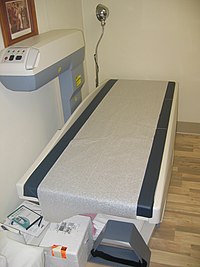
Photo from wikipedia
Purpose To determine the association of epicardial adipose tissue (EAT) volume and density with cardiac geometry and function. Methods We included 178 consecutive patients who performed coronary computed tomography angiography… Click to show full abstract
Purpose To determine the association of epicardial adipose tissue (EAT) volume and density with cardiac geometry and function. Methods We included 178 consecutive patients who performed coronary computed tomography angiography but were not diagnosed with coronary artery disease (CAD). The EAT volume, density, and following cardiac structure and function parameters were measured: left ventricular ejection fraction, left ventricular mass (LVM), left ventricular end-diastolic volume (LVEDV), left ventricular end-systolic volume (LVESV), left ventricular stroke volume (LVSV), left ventricular end-diastolic diameter (LVEDD), interventricular septal thickness (IVST) and posterior wall thickness (PWT). All the parameters were standardized using the height 2.7 . Results A significant correlation was found between larger EAT volume and increased LVM, LVEDV, LVESV, LVSV, LVEDD, IVST and corresponding standardized indexes ( P < 0.05 for all). Higher EAT density significantly correlated with increased LVM, LVEDV, LVESV, LVSV, LVEDD, IVST, PWT and corresponding standardized indexes ( P < 0.05 for all). The largest cardiac structure and function parameters were observed in the population with above-median EAT volume and density. Conclusion Both large EAT volume and high EAT density were associated with cardiac structure and function in patients with no CAD. The EAT density may render complementary information to EAT volume regarding cardiac geometry changes.
Journal Title: Japanese Journal of Radiology
Year Published: 2020
Link to full text (if available)
Share on Social Media: Sign Up to like & get
recommendations!